One of the most anxiety-inducing parts about being a prepper is trying to make sure you are truly ready. I mean to say holistically ready to face whatever comes your way. When it comes to personal preparedness, you get the test first and then you get the lesson assuming you survive.
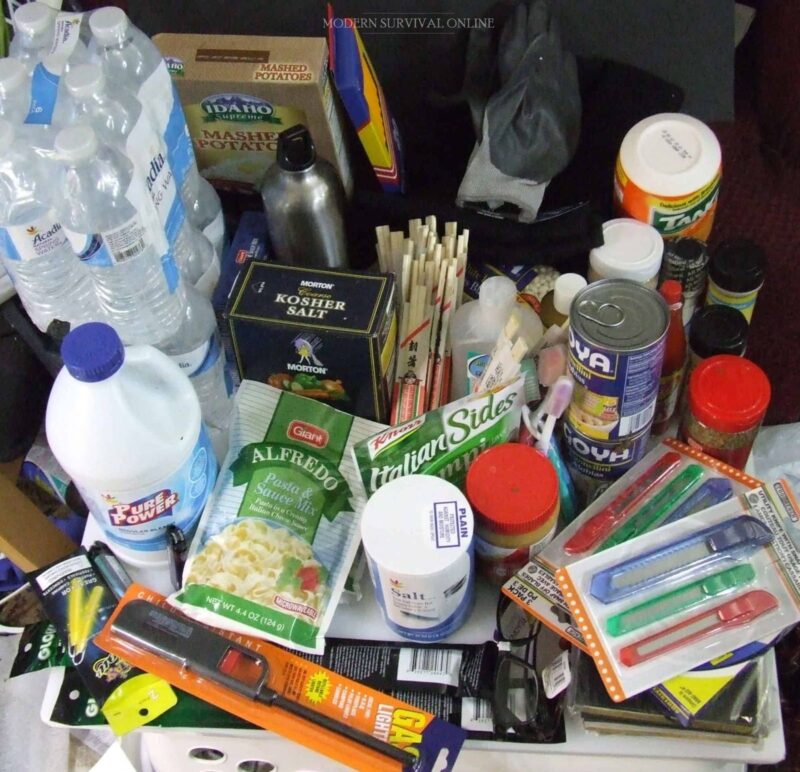
Accordingly, most preppers I know who are serious spend tons of time reviewing and rehearsing their plans, procedures, and lists of equipment and supplies- over and over and over again- until everything is accounted for.
No matter how skilled you are, no matter how much gear and supplies you have on hand, chances are pretty good you’ve missed an element or two. This giant checklist will help you reassess and reevaluate your own readiness by category. Sharpen your pencil and let’s get going.
Water
Water is absolutely critical for life. You know that, I know that, everybody knows that. But it’s easy to forget that you won’t just need water for drinking. You’ll need it for washing, cleaning, laundry and hygiene too.
Gear:
- Water Storage Containers. Water storage containers come in all shapes and sizes, from small bricks you can fit under a bed to giant barrels and tanks that can hold dozens and hundreds of gallons.
- Potable Water. You’d be wise to have water on hand before trouble strikes. Cases of bottled water, gallon jugs, or water you’ve already stashed in the containers above.
- Water Filters. When water stops coming out of a tap, or when treatment systems fail you’ll need a way to make water safe to drink. Water filters such as the Lifestraw remove solid contaminants and some chemicals.
- Purification Chemicals. Water filters can’t get rid of quite everything. For removing biological contaminants like bacteria and viruses solid or liquid purification chemicals can do the job. Make sure you rotate these, they don’t last forever.
- Water Bottles. For taking water with you on the go. Plastic and metal types are both good with pros and cons of their own. Metal ones will let you boil water in them, though.
- Bathtub Basin. An invaluable piece of water storage gear if you are bugging in. Unfold this large bag in your bathtub and fill it up as soon as things go wrong and you’ll have many dozens of gallons of water on hand, convenient and ready to use. The WaterBOB is pretty popular.
Skills:
- Water Purification. Knowing how to properly purify water through various means and using various improvised chemicals (think bleach) and methodologies can keep you and your family alive when all other means fail.
- Natural Water Sources. Do you know where viable natural water sources are? Do you know how you’d get water out of it? Are they relatively clean, totally filthy, or something in between? It pays to know this ahead of time.
- Man-Made Water Sources. If you live in suburbia or in the middle of the city, there will be plenty of places to get water if you know where to look and how to extract it. Pools, pipes, fountains, things like that.
- Safe Storage Techniques. Getting the water is only half the battle. Storing it and keeping it fresh is the other. Learning how to treat your containers and your water to maximize a shelf life and keep germs at bay is essential in a survival situation
Food
You’ve got to eat no matter what’s going on, and though everyone likes to think they can go for weeks without any food the lack of energy will degrade you severely both mentally and physically. Don’t risk it; keep plenty of food on hand and know how to get more.
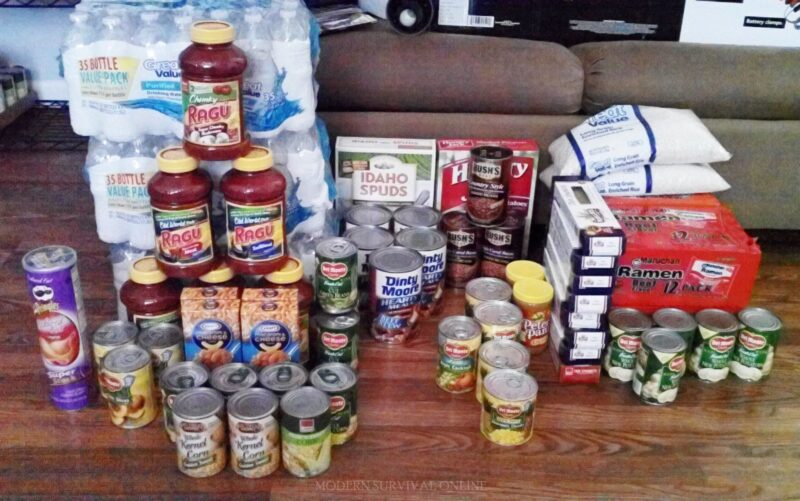
Gear:
- Shelf-Stable Food. All preppers love shelf-stable food. From canned soups, stews, and veggies to trusty standbys like honey, grains, dried beans, and more. You’ll need around 2,000 calories per day per adult in your household or group.
- Utensils and Plates. Nobody wants to eat with their hands like some kind of animal. Make sure you’ve got utensils and plates for everyone. You can make a good case for disposables at least in the short term to cut down on water usage.
- Cookware. If you want to prepare food you’ve got to have something to heat it or cook it in. A cook set for your home or a portable camping cutlery set (if you are on the move) is necessary.
- Alternate Cooking Appliance. Assume that your microwave, stove top, and other usual appliances are out of commission. Do you have another way to cook? Fireplace, charcoal or gas grill, camp stove? You have a large supply of firewood, and a fire pit?
- Vacuum Sealer. Vacuum sealers are a godsend for preppers, dramatically increasing the shelf life of dry goods and all kinds of other foods by keeping out oxygen, bugs, and moisture. Probably won’t help much during a survival scenario, but storing your food with one ahead of time is a great move.
- Food Storage Buckets. For stashing massive amounts of basic staples like grains, beans, salt, and sugar, food storage buckets are tops. You can also use them for making individual menus or caches of food that can easily be handed off to neighbors or family members.
Skills:
- Canning. Everybody knows someone who cans, and if you don’t have anyone in your family that does, it’s time for you to start. Canning is one of the best skills you can learn to expand your own survival food stash.
- Storing and Rotating. Preserving the food is only half of it. Storing it properly for maximum longevity and rotating it before it spoils so you always have a viable stock on hand is the other half. It can be a logistically challenging administrative task, so make sure you master it now.
- Improvised Cooking. If you didn’t have a single thing to cook with, not even a utensil, could you manage? Learning how to cook well enough and safely enough even in the most austere environments is a good skill for prayers.
- Prepper Recipes. Let’s face it, most of your favorite foods will be long gone when the chips are really down. But knowing how to whip up a reasonable facsimile of peach cobbler from canned fruit and Bisquick or put together chili mac from instant pasta and dried ground beef can boost spirits and beat menu fatigue.
Shelter
It is exposure, not dehydration, that is the single most common and most lethal killer in survival situations of all kinds.
Especially when the weather turns cold, if you can’t stay warm you won’t have to worry about staying warm ever again if you take my drift. You must be prepared to provide or create shelter no matter the conditions and situation.
Gear:
- Tents. A tent will allow you to get inside out of the wind and rain no matter the situation. Ideally, it will be spacious enough for at least a couple of adults. They even come in handy inside a home when the power is out.
- Sleeping Bags. Wriggling down into a sleeping bag will be quite comforting indeed when you are very cold and there is no chance of obtaining heat from any source. A good sleeping bag can keep you alive even in the most severe weather.
- Blankets. It’s always good to curl up with a blanket, and survival or space blankets can help hold in upwards of 90% of your body heat. They’re light, portable and affordable. Get some.
- Adequate Seasonal Clothing. Wherever you live, you must have adequate seasonal clothing for all weather conditions in all seasons that are reasonably likely to occur. Make sure you have more than one set to allow for damage and washing.
- Home Repair Materials. The event that starts the emergency might damage your home and compromise the protection it affords from the elements. Having basic building supplies and tools on hand can help you shore up damage.
- Plastic Sheeting. Plastic sheeting comes in really handy for blocking drafts, patching up busted windows, and keeping water out. Make sure you have a few extra large rolls.
- Duct Tape. You know it, you love it. Duct tape can fix anything, at least temporarily, and is invaluable when you are repairing or waterproofing a damaged home.
Skills:
- Principles of Thermoregulation. Understanding the principles behind keeping warm and more importantly the factors of heat loss will allow you to make good decisions to keep warm, and cool down likewise.
- Creating a Microclimate. Similarly, understanding how to create a microclimate, a small contained environment that is easy to heat or cool, is greatly beneficial whether you are indoors or out.
- Construction and Repair. Providing substantial shelter usually involves a certain amount of building, even if it is just a primitive shelter made from all-natural materials. These skills also come in handy for repairing your home as you might imagine.
- Improvised Shelters. There are dozens of classic primitive and improvised shelters that can be made from all-natural and man-made materials. They’ve worked for countless generations before we got here, and they work today. Know how to make a few for any environment.
Stockpiling
A big part of prepping is just having enough on hand. And by enough I mean enough of whatever you need. Aside from food and water, it’s going to be clothing, tools, fasteners, consumables, medicine, spare parts, and anything else you can think of.
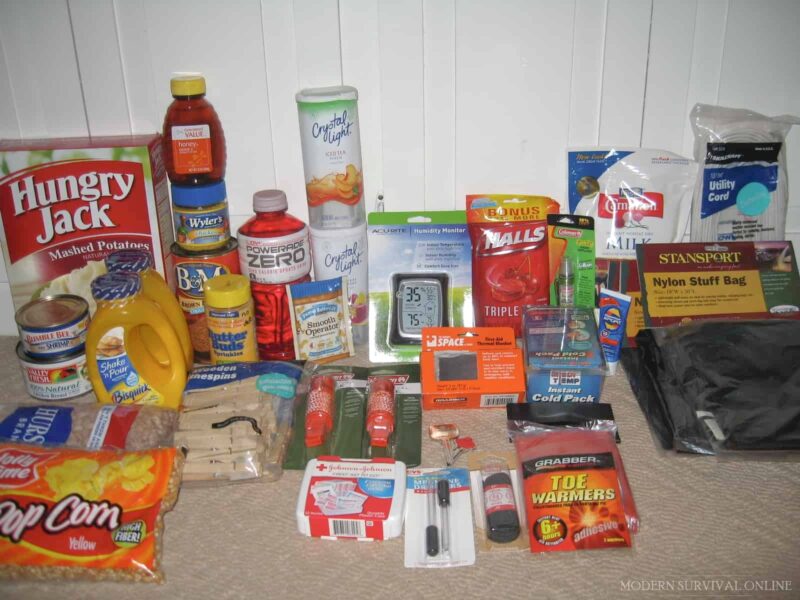
Gear:
- Shelves. Maximizing storage space is only possible if you’ve got shelves. Make sure your shelves are sturdy enough and wide enough to hold everything that you need.
- Containers. Containers prevent clutter. Enough said, and they also make it easier to move and rearrange your supplies and gear.
- Checklists. Checklists cannot be beat for keeping track of what you have, what you need, and what you need to do.
- First-Aid. Lots of preppers overlook the importance of medical supplies and first aid materials among their stores. Don’t be one of them. Remember, having enough supplies on hand might allow someone with the skills to save your life or someone else’s.
- Medicine. Medicines of all kinds are another critical item in any prepper survival stash. Over-the-counter medications of all kinds, of course, but also prescription medications that you or loved ones need. Make sure you rotate them, they don’t last forever.
- Batteries. All kinds of essential gear, from flashlights to lanterns, cameras, night vision goggles, and a lot more depend on batteries. You’ve got to feed the machine if you want it to work, so accordingly you’ll need plenty of these.
Skills:
- Planning. Planning around likely consumption rates and contingencies can be brain-twisting but it is necessary if you want to stockpile enough goods and gear to last.
- Rotation and Inspection. Just as important as planning are rotation and inspection. Things can go bad simply from sitting in storage too long, and consumables like medicine and batteries slowly go bad over time. Learning how to inspect and rotate all of your gear and supplies at regular intervals will prevent a nasty surprise.
- Barter. Just because your region or the entire world has gone to pot doesn’t mean people won’t trade among themselves to get what they need. They always have and they always will. Learn how to barter and haggle the right way so you can always make a deal when you need to.
Communications
Keeping in touch is always paramount in a survival scenario. Whether it is maintaining radio communications with your friends and family, signaling to rescuers, or discreetly warning your scouts that something nasty is waiting as they come back, communication skills and gear are a must-have.
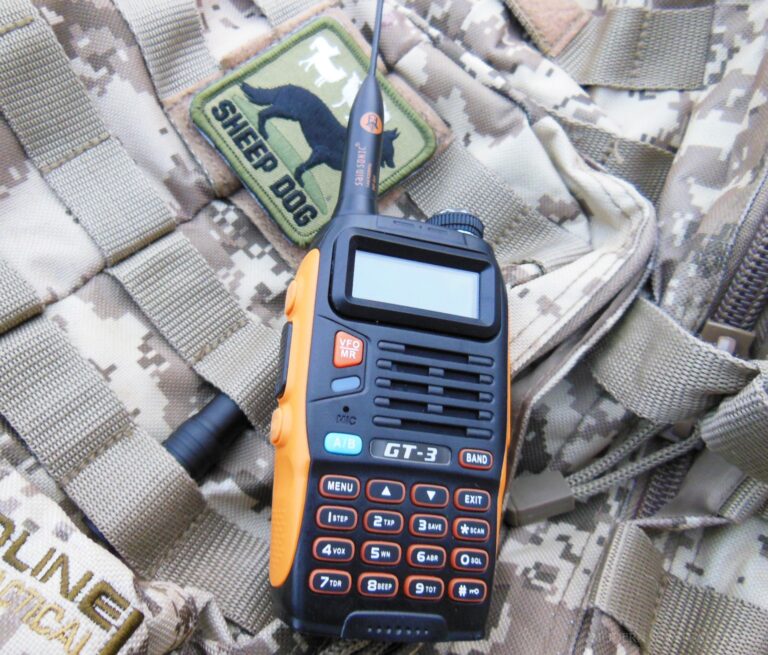
Gear:
- Backup Cellphone. Don’t be so quick to think that your phone will be useless when the balloon goes up. Under most circumstances, it will continue to work even if it is in a degraded capacity. Modern smartphones are borderline wondrous in their capability, so it’s good to have a backup against loss or destruction.
- Power Bank. Your phone, just like all other electronics, is a power-hungry little gremlin. Keep it alive during critical moments with a power bank that you can connect to it.
- Walkie-Talkies. Sometimes cellular networks will be too busy or will actually be down and in that case, the next best way to keep in touch with an individual is by using a walkie-talkie.
- Ham/GMRS Radioset. Walkie-talkies don’t reach very far. A ham radio or a GMRS radio set will indeed reach out a lot farther. These aren’t intuitive to use, so you’ve got to have the accompanying skillset.
- Emergency/Weather Radio. Sometimes you don’t need to talk to anyone, but you do need to know what’s going on. Listen for updates from regional and national authorities by tuning into a specialty emergency or weather radio set. Most feature a built-in crank dynamo so they can always be powered.
Skills:
- Radio Operation. Want to make use of that walkie-talkie, ham radio, or GMRS set? You’ll have to learn the principles of radio communication and also the basic procedures for operating any given type of radio set.
- Morse Code. An old, eccentric and intricate mode of communication but still an entirely viable one that is worth learning. Even better, it works visually and through sound, making it highly adaptable with a little bit of creative thinking.
- Semaphore. Semaphore, also known as flag code, is typically used to visually communicate between two ships at sea but it has many other uses besides including passive signaling. Another golden oldie well worth learning.
- Family/Neighborhood Comms Plan. One of the most essential skills. Learning how to put together a family or, if applicable, neighborhood comms plan so friends and neighbors can reestablish communication links with each other when the usual go-to’s fail might be the difference between disaster and survival.
Getting Home
Many preppers fail to plan that sometimes the first and indeed most difficult part of a survival situation could just be getting home or all of your preps and loved ones are. This can be a survival situation and challenge unto itself, one that you should prepare for.
Gear:
- Get-Home Bag. Unless you are truly a house mouse, you go out at regular intervals for something. Maybe it’s work, school, or facilitating someone else’s activities. For this reason, you need to get home back. A lightweight bag of supplies that will enable you to move home as quickly as possible with or without your vehicle.
Skills:
- Shelter and Evasion Plan. If you travel the same regular routes week in and week out, or are a dedicated commuter, you should put together a shelter and evasion plan for lengthy moves home. Knowing where you can lay up for a time, get some rest, or get away from trouble that might be pursuing you can save your life.
- Family Contingency Plan. Your loved ones might be going crazy if you aren’t at home when the event kicks off. Or, they too might be scattered to the four winds. An intricate and carefully rehearsed family contingency plan will help everyone link up and rendezvous as quickly and as smoothly as possible.
- Cardio. When it comes to getting home, cardio will make all the difference. You must assume that you won’t just be able to turn your car around and drive there. Plan on a long, grueling foot movement home. If you can’t keep moving at of brisk pace, it’ll take longer than it should, or you might just wind up dead.
Bugging-In
Lots of peppers dream of grabbing their pack and bugging out when the sky turns dark, but invariably a much better and safer option if you’re able to just bug in. Stay put, batten down the hatches, and make use of all this carefully stashed gear we are talking about here.
Gear:
- Heavy-Duty Contractor Bags. If you were staying put at home or anywhere else, you must assume that you’ll be responsible for dealing with garbage and human waste alike. Believe me when I say that an immense supply of heavy-duty contractor bags will make both challenges a lot simpler and more tolerable.
- Camp Toilet. You cannot count on your indoor plumbing to keep working in a major situation, especially in the aftermath of a destructive disaster or other event. A camp toilet will allow you to keep doing your business more or less as you always have, and will make waste management a lot more straightforward compared to an improvised method.
- Everything Else on this list. No joke here. Basically, everything we are discussing on our checklist is intended to help you get home or to another location and then stay there, riding out whatever comes with the things you need to survive.
- Battery Bank. A whole-house battery bank can offer plenty of power to keep lights on, run appliances, charge devices, and a lot more. They are expensive and require money or significant electrical work experience to set up and install, but are well worth it for the freedom, flexibility and energy economy they can provide you in a long- or unknown-duration event.
- Generator. When you need to supply power to vital appliances, your home, or power tools, nothing beats a generator. You can even get a whole-house generator for full-time backup power. Combined with a battery bank system your unused power can be stored for future use, maximizing fuel economy. Consider a dual-fuel model for versatility.
- Sandbags. For holding back floodwater or stopping bullets, nothing beats a stack of sandbags. You’ll need plenty of clean sand or dirt and lots and lots of labor to fill them when needed, but nothing works as well as they do when things are looking really hairy.
Skills:
- Home-Defense. The world will go crazy if something really terrible happens. Even in the case of localized and regional disasters, the worst parts of humanity always come scurrying out of the cracks. It’s terrible to think about, but you must be prepared to deal with them if they come for what you have.
- Sanitation Protocols. Any group of people that stays in one place long enough will generate tremendous amounts of waste, household garbage, and bodily waste alike. Learning how to properly manage, handle, and dispose of this waste is critical to prevent devastating outbreaks of disease.
- Leadership. Keeping people focused, reasonably calm, and working together is difficult in the best of times. During a crisis event, it is a nightmare. Your leadership skills will be put to a severe test so work on them now.
- Bug-Out Plan. As much as we want to bunker down at home or at another fixed location, the situation might dictate that that is impossible. Having a bug-out plan is still mandatory.
Bugging Out
Like I said just above, sometimes you don’t get any choice of whether or not you can stay put. Whether you need to move to a pre-selected fallback point or just get the hell out of Dodge having the right bug-out gear and bug-out skills might be the only thing that keeps you alive.
Gear:
- Bug-Out Bag. A bug-out bag is basically a mobile store room containing most of the survival necessities that you’ll need to stay alive and sustain while moving to a safer location. I’ll talk more about it in the next section.
- Maps. Do you know where you’re going and how you’re going to get there? You really don’t if you don’t have maps.
- Good Boots. There’s a non-zero chance you might have to hoof it to get to where you were going. Your footwear, whatever it is, must be durable and up to the task.
Skills:
- Land Navigation. Learning how to read the terrain and correlate it with a map whether you are hiking or driving is a fundamental bug-out skill.
- Route Planning. Well before the fateful day comes, understanding all of the variables attendant with choosing a route for maximum speed, safety or discretion is crucial.
- Concealment. If things are bad enough that you are bugging out, you’ll probably have cause to avoid people, stay out of sight, and mind your own business. Concealment and evasion skills will help you keep a low profile.
- Rucking. You don’t know what it’s truly like to bug out on foot until you are hauling an immensely heavy backpack with you every step of the way. Practice rucking now or curse it later.
Bug-Out Bag
More ink has been spilled on bug-out bags than any other topic in prepperdom. There’s a good reason for it, because a BOB is the equivalent to a parachute when things really go wrong.
Gear:
- Food. Portable, calorie-dense, and shelf-stable rations are what belong in a bug-out bag.
- Water. You’ll need a little bit of water to get you started, but containers, filters, and chemicals to treat gathered water as you go.
- Shelter. Tent or bivy, ground pad, hammock, blanket.
- Tools. Knife, hatchet, folding saw, multi-tool. Things to help you make and fix.
- Clothing. Seasonally appropriate clothing with additional layers as they might be required.
- Fire-Starting. Fire is always needed in a survival situation. Matches, lighters, ferro rods, and similar tools will help you make it.
- Self-Defense. You’ll likely run into dangerous people and dangerous critters when bugging out. A few trusty weapons will help keep you safe.
Skills:
- Packing. It sounds funny, but learning how to properly pack a bug-out bag for maximum comfort, efficiency, access, and load-carrying capability is foundational to success. A sloppily packed bag is likely to break or it will just make you utterly miserable and wear you out.
Bug-Out Vehicle
If you are fortunate, clever, or just very good it is possible to bug out using your vehicle. This is a great way to increase speed, safety, and security but it is a skill set and sector for preparation unto itself.
When you visit an external link on this page and then make a purchase, I may earn a commission. Read my full advertising disclosure here.
Gear:
- Spare Parts. No matter what sort of vehicle you were relying on to ferry you to safety, no matter how well maintained it is, there’s a chance that things will break when you can least afford it. Spare parts, along with the right tools and skills, will get you running again.
- Cargo Racks/Bays. One of the best advantages any vehicle can offer you is expanded cargo room for the things that you and others need to survive, and without having to carry it on your back. Whether it is external cargo baskets and rooftop racks, a truck bed or something else make sure your vehicle can carry what you need.
- Good Tires. Good, sturdy, well-maintained tires will help you negotiate most terrain that your vehicle could be expected to cross in the first place. Cheap tires are more likely to blow out, again when you can least afford it.
- Flat Tire Kit. No matter how good your tires are, I guarantee you they will go flat. They will, not might. A flat tire kit consisting of patches and a good jack can get you back on the road quickly enough.
- Spare Tire. Sometimes a tire cannot be fixed or reinflated. Or it cannot be repaired in a timely fashion. Fix it later; throw a full-size spare on there and get back on the road.
- Jump Box. Batteries are another notorious failure point for most vehicles. Unlike most times, you won’t be able to depend on someone willingly and cheerfully giving you a jump. A high-quality, charged jump box will let you give that battery a boost to get you back on the road.
- Portable Compressor. Fixing a flat is only part of the solution. The other part is getting air back in the tire. Forgot your compressor? I hope not.
- Drone. Don’t neglect the huge intel-gathering and reconnaissance capability that a drone provides. Modern drones are surprisingly affordable, have long ranges, can operate at high altitudes (comparatively speaking), and can provide high-def, real-time video of terrain, people, and problems. Sending a drone out to scout routes and look for threats during a stop or bivouac is a great idea when conducting a vehicular bug-out.
Skills:
- Performance Driving. Dropping onto the shoulder at speed, going off-road, hopping a curb, tackling an incline, dodging a speeding or wrecked car. All of this and a lot more might happen during a vehicular bug out and if you don’t know how to handle your vehicle in these extremes you are going to become another casualty on the side of the road.
- Route Assessment/Selection. Picking a route based on known data is something you’ll have to do even when you don’t have the whole picture, but then learning to read and adapt to changing conditions and, if necessary, detour on the fly will keep you moving and keep your family alive.
Homesteading
As hard as it is to contemplate, the world might not go back to normal for a very, very long time if it ever does. But, life must go on, and it will go on in a way that is a lot simpler and more like things used to be. This means you might be living on a modern homestead.

Gear:
- Land. If you want to have a plot to call your own you’ve got to have a plot. You needn’t think you’ll be able to squat or just lay claim to any parcel that looks appealing when the time comes.
- Cabin/House. If you were settling in for the long haul in a new and strange world, you’d need a proper homestead. It could be something as simple as a primitive cabin or identical to the houses that we live in today. Whatever it looks like, it needs to be move-in ready.
- Livestock. Different livestock species can provide all sorts of valuable materials and supplies along with food. Whether you’ve got a ton of room or just a little, there is a species that will work for you.
- Garden. People have been growing their own food for sustenance basically forever, but as you’d expect it takes a long time for fruits, veggies, and grains to grow. You need to get a garden started before you need it.
Skills:
- Animal Husbandry. If you think taking care of a pet is hard, wait until you get to take care of a whole bunch of animals! Even more complicated, different species have vastly different needs and you’ve got to learn all of them if you want your animals to take care of you.
- Gardening. As with animals, taking care of different plants is a lot more complicated than neophytes think. Soil quality, climate factors, fertilization, pests, diseases, and lots of other factors interact if you want a big harvest. This is not a test you want to cram for when winter is approaching!
- Maintenance. Self-sufficiency is the name of the game, and that means solving your own problems, specifically when things break down, wear out, or stop working as expected. Being a jack-of-all-trades when it comes to the construction and maintenance of structures and machines alike can make all the difference on a homestead.
- Hunting. Sometimes you simply have to go out there and bag dinner yourself, and when it comes to nutrition hardly anything is better than fresh, high-quality, wild-sourced meat. Whether you don’t have any animals fit for slaughter or you just looking to supplement your stores, there are plenty of animals out in nature that make for good eating if you can bring them down.
Everyday Carry (EDC)
So many of the emergencies that accost us are barely newsworthy as far as the rest of the world is concerned, though they can change our lives and not for the better. Be ready for these micro disasters by carrying a few smart tools to make sure you get to go home at the end of the day.
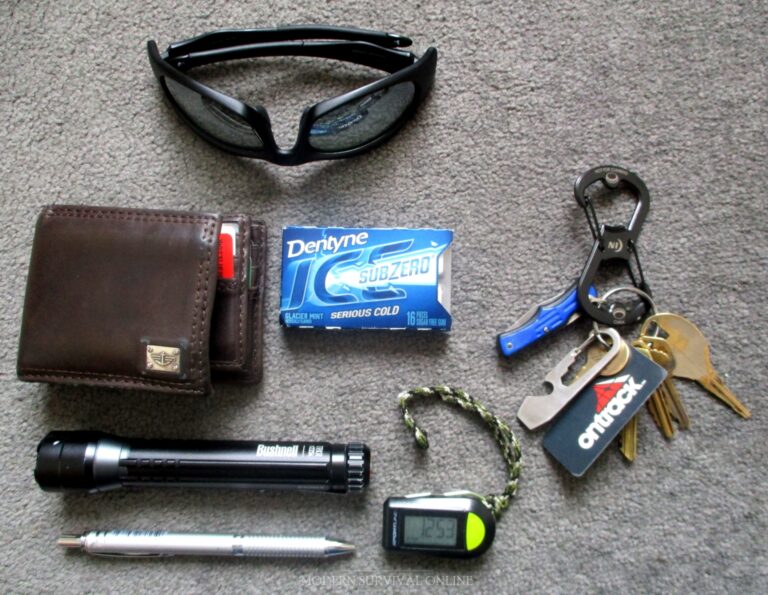
Gear:
- Flashlight. One of the single most useful tools that any prepper can have. People are just no good in the dark, and whether you’re moving into a darkened building interior or basement, or caught outside at nighttime, a flashlight will help keep you safe.
- Tourniquet. One of the leading causes of death from injury and accident is exsanguination due to an extremity hemorrhage; basically bleeding to death from a wound to a limb. A tourniquet, and the skills to use it, can save you or someone else from this unfortunate fate.
- Multi-Tool. A good multi-tool, be it a pliers-type like a Leatherman or a classic Swiss army knife, will let you deal with 90% of the tasks, chores, and quick fixes that you’ll encounter. If it’s good enough for a MacGyver it’s good enough for us!
- Pocketknife. Every prepper knows that a good knife is the first and foremost tool for confronting the world. No one should ever leave the house without a pocketknife and that’s a fact.
- Bandana. A bandana is not just a fashion statement. You don’t even have to wear it to get used to it! It can be used as an improvised bandage, for blotting sweat, carrying small parts, and countless other tasks. Your granddad carried a handkerchief at all times and you should too.
- Pepper Spray. Pepper spray is one of the very best self-defense options available, and is highly effective at shutting down confrontations before they start. Even better, it rarely inflicts any permanent harm so your liability from using it is much lower. If somebody’s getting froggy and you’re not justified in using lethal force, pepper spray is the answer.
Skills:
- First-Aid. First aid skills are indispensable, and you’ll have more opportunity to use them than nearly any other emergency skill set, especially outside of your home. CPR, dealing with broken bones, lacerations, and other ailments, these and more should be at the top of your training list.
- Verbal Judo. Lots of folks, especially armed folks, gravely underestimate the utility of knowing how to talk your way out of a bad situation. It is a much subtler art than you might think, and understanding cultural, class, and lifeway differences along with some choice words at the right time could keep you from being jumped.
- Combatives. When it comes to self-defense, you’ll have way, way more opportunity to protect yourself using fists and feet than you will with lethal force in the form of a gun or knife. If you are carrying a lethal force option but don’t know how to handle yourself in a fistfight, you’ve got everything backwards. Boxing, judo, MMA, all can serve as great foundations for a well-rounded fighter.
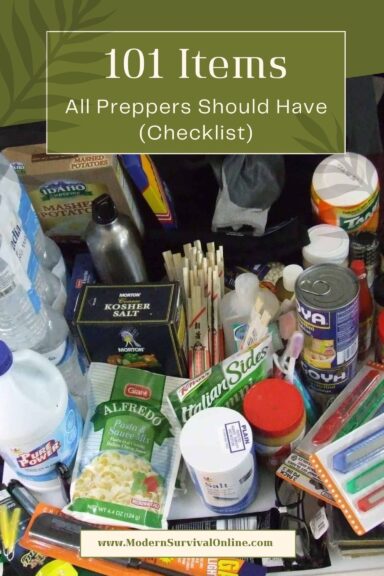

Like what you read?
Then you're gonna love my free PDF, 20 common survival items, 20 uncommon survival uses for each. That's 400 total uses for these dirt-cheap little items!
We will not spam you.